Developing Cross-Cultural Capability for SME Business Expansion
VerifiedAdded on 2022/12/14
|11
|3105
|357
Report
AI Summary
This report examines the cross-cultural capabilities necessary for a shoe manufacturing SME based in Northampton to successfully expand its business and production into China, Vietnam, or Ethiopia. The report explores the importance of cross-cultural understanding in a globalized business environment, including the key elements of cross-cultural capabilities such as intercultural awareness, communication skills, and international perspectives. It analyzes opportunities and risks associated with partial manufacturing shifts, emphasizing the importance of human resource values like integrity, customer focus, and employee development. The report also addresses potential issues and challenges, such as language barriers and cultural differences, and delves into cross-cultural dimensions using models like Hofstede's and Trompenaars' to understand cultural differences in time perception, communication styles, power distance, individualism vs. collectivism, masculinity vs. femininity, uncertainty avoidance, and more. The study offers a comprehensive overview of the complex factors influencing the development of global business operations.
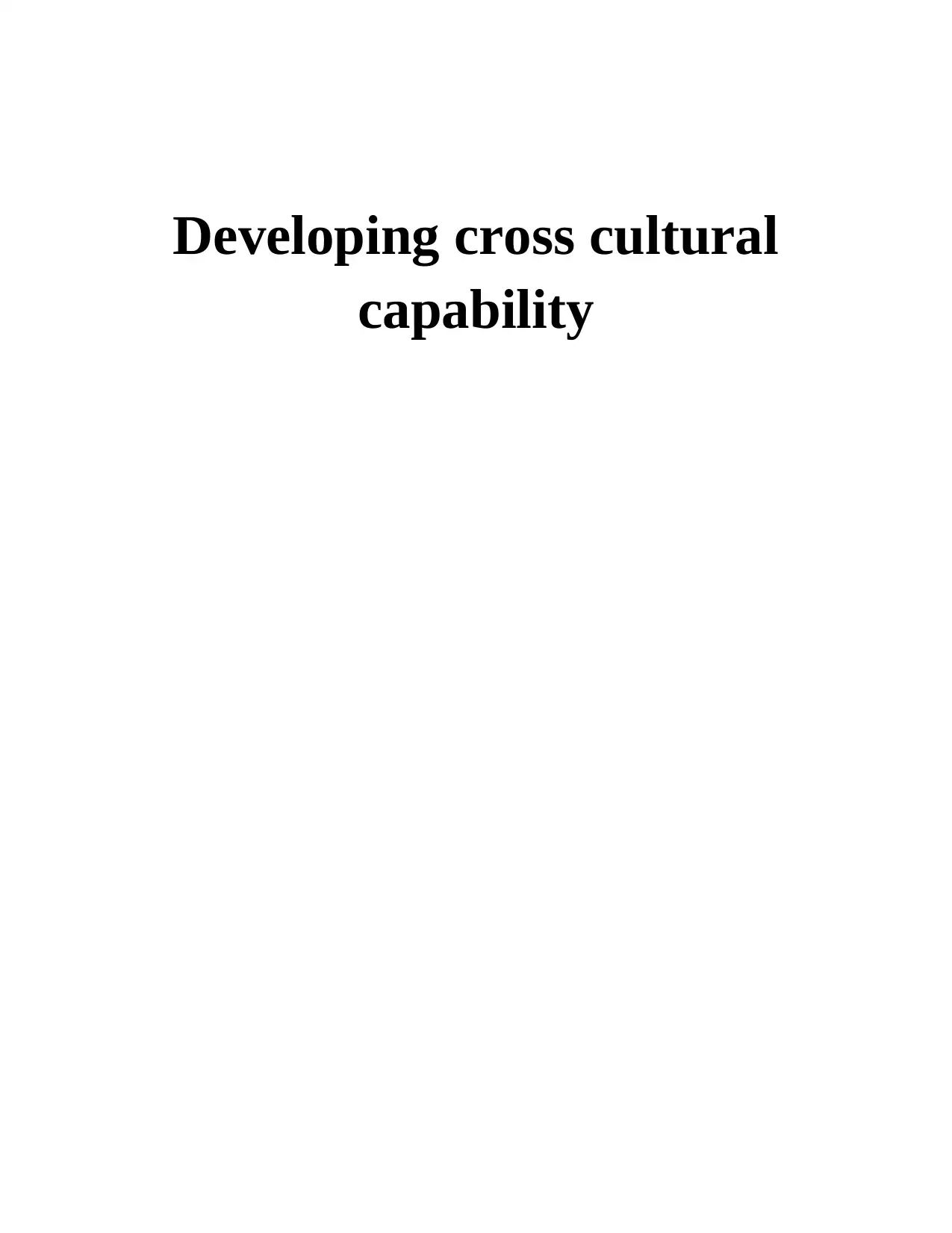
Developing cross cultural
capability
capability
Paraphrase This Document
Need a fresh take? Get an instant paraphrase of this document with our AI Paraphraser
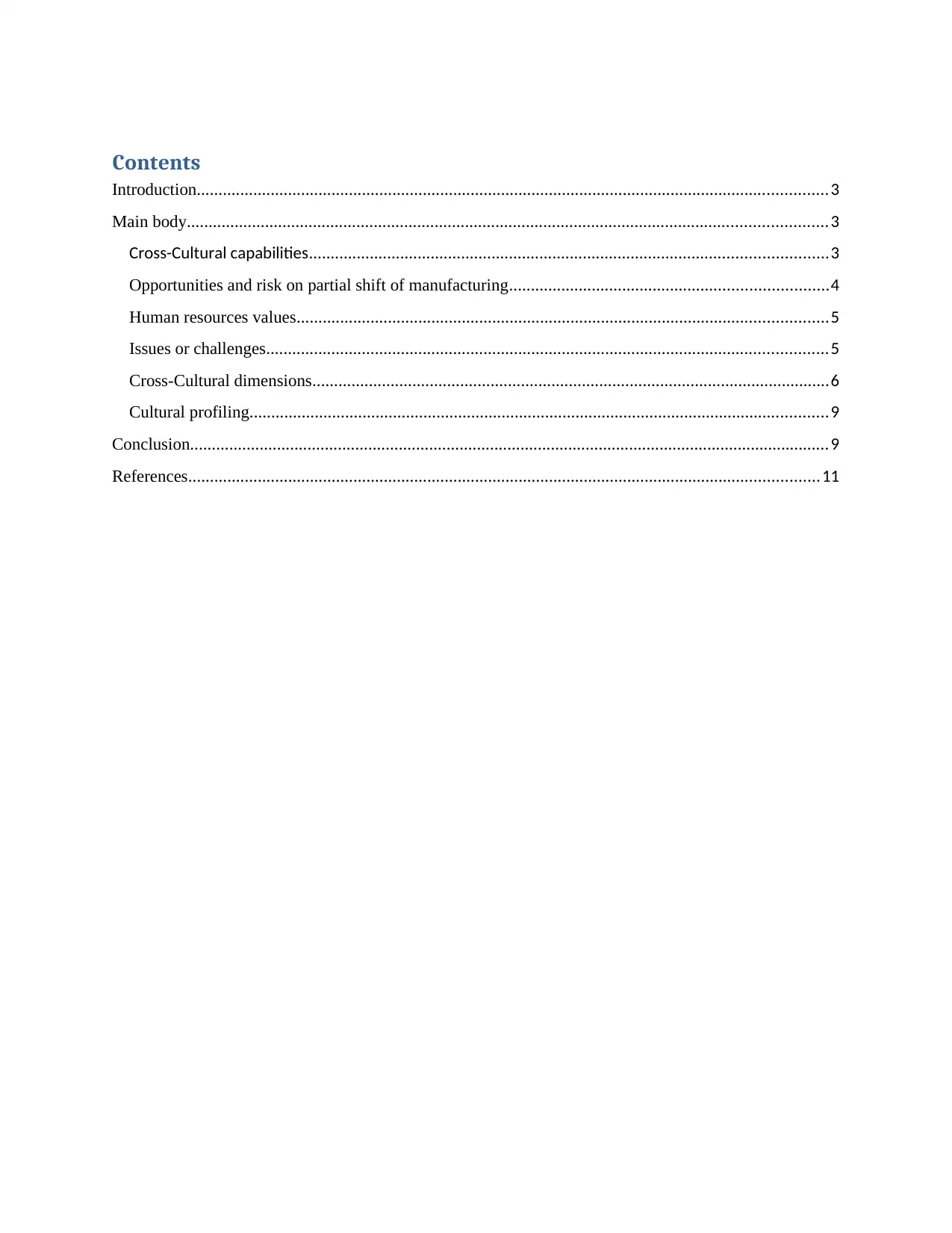
Contents
Introduction.................................................................................................................................................3
Main body...................................................................................................................................................3
Cross-Cultural capabilities.......................................................................................................................3
Opportunities and risk on partial shift of manufacturing.........................................................................4
Human resources values..........................................................................................................................5
Issues or challenges.................................................................................................................................5
Cross-Cultural dimensions.......................................................................................................................6
Cultural profiling.....................................................................................................................................9
Conclusion...................................................................................................................................................9
References.................................................................................................................................................11
Introduction.................................................................................................................................................3
Main body...................................................................................................................................................3
Cross-Cultural capabilities.......................................................................................................................3
Opportunities and risk on partial shift of manufacturing.........................................................................4
Human resources values..........................................................................................................................5
Issues or challenges.................................................................................................................................5
Cross-Cultural dimensions.......................................................................................................................6
Cultural profiling.....................................................................................................................................9
Conclusion...................................................................................................................................................9
References.................................................................................................................................................11
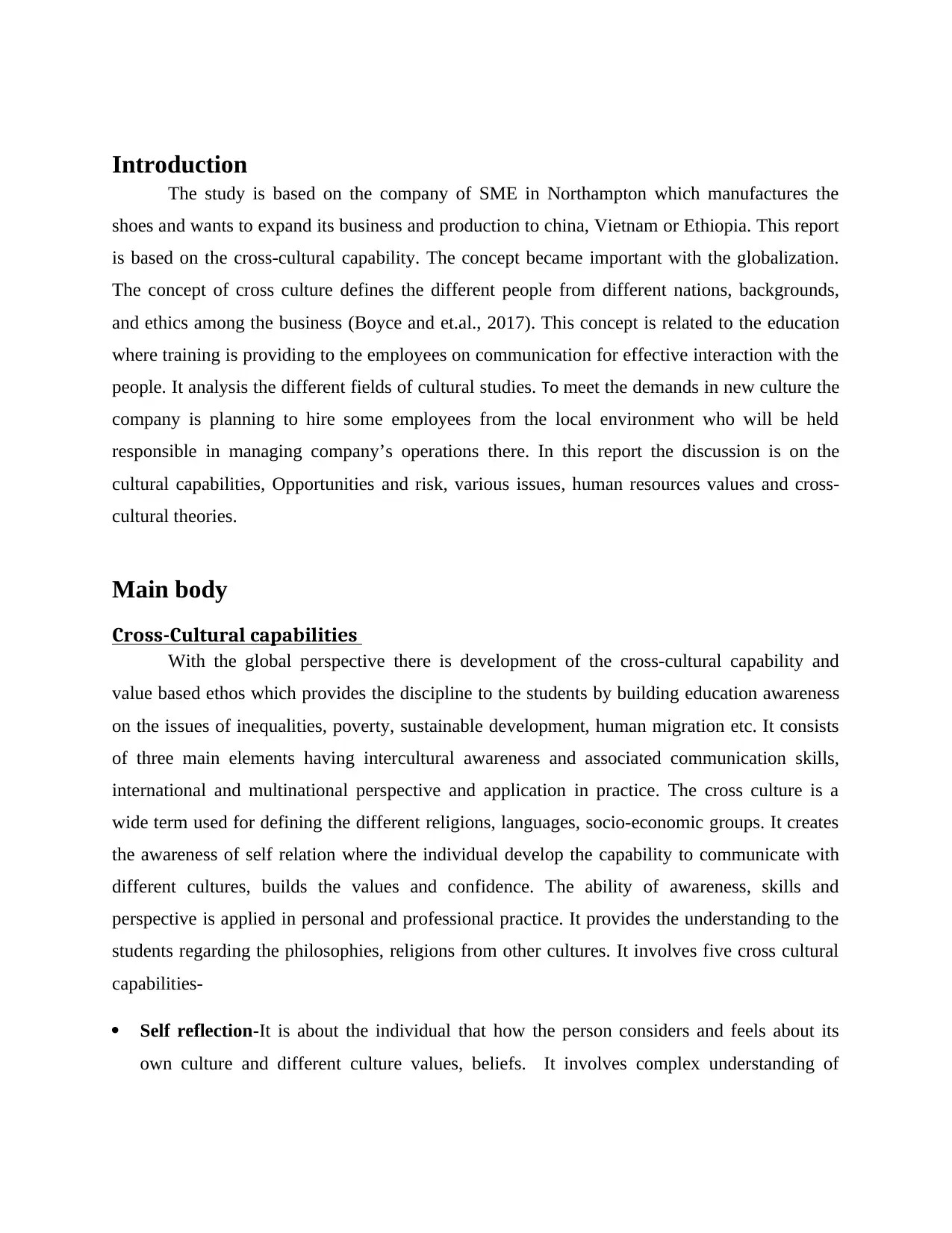
Introduction
The study is based on the company of SME in Northampton which manufactures the
shoes and wants to expand its business and production to china, Vietnam or Ethiopia. This report
is based on the cross-cultural capability. The concept became important with the globalization.
The concept of cross culture defines the different people from different nations, backgrounds,
and ethics among the business (Boyce and et.al., 2017). This concept is related to the education
where training is providing to the employees on communication for effective interaction with the
people. It analysis the different fields of cultural studies. To meet the demands in new culture the
company is planning to hire some employees from the local environment who will be held
responsible in managing company’s operations there. In this report the discussion is on the
cultural capabilities, Opportunities and risk, various issues, human resources values and cross-
cultural theories.
Main body
Cross-Cultural capabilities
With the global perspective there is development of the cross-cultural capability and
value based ethos which provides the discipline to the students by building education awareness
on the issues of inequalities, poverty, sustainable development, human migration etc. It consists
of three main elements having intercultural awareness and associated communication skills,
international and multinational perspective and application in practice. The cross culture is a
wide term used for defining the different religions, languages, socio-economic groups. It creates
the awareness of self relation where the individual develop the capability to communicate with
different cultures, builds the values and confidence. The ability of awareness, skills and
perspective is applied in personal and professional practice. It provides the understanding to the
students regarding the philosophies, religions from other cultures. It involves five cross cultural
capabilities-
Self reflection-It is about the individual that how the person considers and feels about its
own culture and different culture values, beliefs. It involves complex understanding of
The study is based on the company of SME in Northampton which manufactures the
shoes and wants to expand its business and production to china, Vietnam or Ethiopia. This report
is based on the cross-cultural capability. The concept became important with the globalization.
The concept of cross culture defines the different people from different nations, backgrounds,
and ethics among the business (Boyce and et.al., 2017). This concept is related to the education
where training is providing to the employees on communication for effective interaction with the
people. It analysis the different fields of cultural studies. To meet the demands in new culture the
company is planning to hire some employees from the local environment who will be held
responsible in managing company’s operations there. In this report the discussion is on the
cultural capabilities, Opportunities and risk, various issues, human resources values and cross-
cultural theories.
Main body
Cross-Cultural capabilities
With the global perspective there is development of the cross-cultural capability and
value based ethos which provides the discipline to the students by building education awareness
on the issues of inequalities, poverty, sustainable development, human migration etc. It consists
of three main elements having intercultural awareness and associated communication skills,
international and multinational perspective and application in practice. The cross culture is a
wide term used for defining the different religions, languages, socio-economic groups. It creates
the awareness of self relation where the individual develop the capability to communicate with
different cultures, builds the values and confidence. The ability of awareness, skills and
perspective is applied in personal and professional practice. It provides the understanding to the
students regarding the philosophies, religions from other cultures. It involves five cross cultural
capabilities-
Self reflection-It is about the individual that how the person considers and feels about its
own culture and different culture values, beliefs. It involves complex understanding of
⊘ This is a preview!⊘
Do you want full access?
Subscribe today to unlock all pages.

Trusted by 1+ million students worldwide
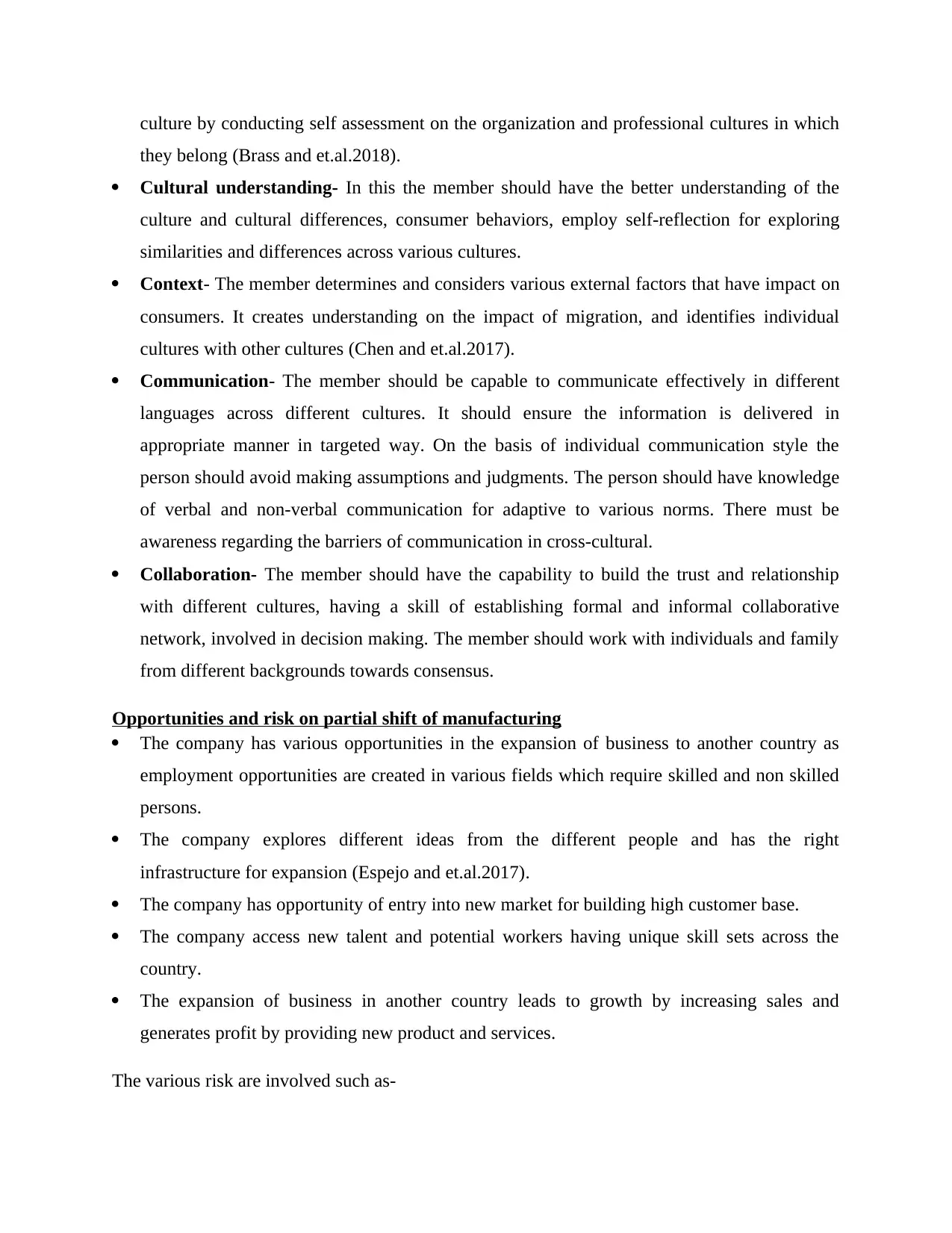
culture by conducting self assessment on the organization and professional cultures in which
they belong (Brass and et.al.2018).
Cultural understanding- In this the member should have the better understanding of the
culture and cultural differences, consumer behaviors, employ self-reflection for exploring
similarities and differences across various cultures.
Context- The member determines and considers various external factors that have impact on
consumers. It creates understanding on the impact of migration, and identifies individual
cultures with other cultures (Chen and et.al.2017).
Communication- The member should be capable to communicate effectively in different
languages across different cultures. It should ensure the information is delivered in
appropriate manner in targeted way. On the basis of individual communication style the
person should avoid making assumptions and judgments. The person should have knowledge
of verbal and non-verbal communication for adaptive to various norms. There must be
awareness regarding the barriers of communication in cross-cultural.
Collaboration- The member should have the capability to build the trust and relationship
with different cultures, having a skill of establishing formal and informal collaborative
network, involved in decision making. The member should work with individuals and family
from different backgrounds towards consensus.
Opportunities and risk on partial shift of manufacturing
The company has various opportunities in the expansion of business to another country as
employment opportunities are created in various fields which require skilled and non skilled
persons.
The company explores different ideas from the different people and has the right
infrastructure for expansion (Espejo and et.al.2017).
The company has opportunity of entry into new market for building high customer base.
The company access new talent and potential workers having unique skill sets across the
country.
The expansion of business in another country leads to growth by increasing sales and
generates profit by providing new product and services.
The various risk are involved such as-
they belong (Brass and et.al.2018).
Cultural understanding- In this the member should have the better understanding of the
culture and cultural differences, consumer behaviors, employ self-reflection for exploring
similarities and differences across various cultures.
Context- The member determines and considers various external factors that have impact on
consumers. It creates understanding on the impact of migration, and identifies individual
cultures with other cultures (Chen and et.al.2017).
Communication- The member should be capable to communicate effectively in different
languages across different cultures. It should ensure the information is delivered in
appropriate manner in targeted way. On the basis of individual communication style the
person should avoid making assumptions and judgments. The person should have knowledge
of verbal and non-verbal communication for adaptive to various norms. There must be
awareness regarding the barriers of communication in cross-cultural.
Collaboration- The member should have the capability to build the trust and relationship
with different cultures, having a skill of establishing formal and informal collaborative
network, involved in decision making. The member should work with individuals and family
from different backgrounds towards consensus.
Opportunities and risk on partial shift of manufacturing
The company has various opportunities in the expansion of business to another country as
employment opportunities are created in various fields which require skilled and non skilled
persons.
The company explores different ideas from the different people and has the right
infrastructure for expansion (Espejo and et.al.2017).
The company has opportunity of entry into new market for building high customer base.
The company access new talent and potential workers having unique skill sets across the
country.
The expansion of business in another country leads to growth by increasing sales and
generates profit by providing new product and services.
The various risk are involved such as-
Paraphrase This Document
Need a fresh take? Get an instant paraphrase of this document with our AI Paraphraser
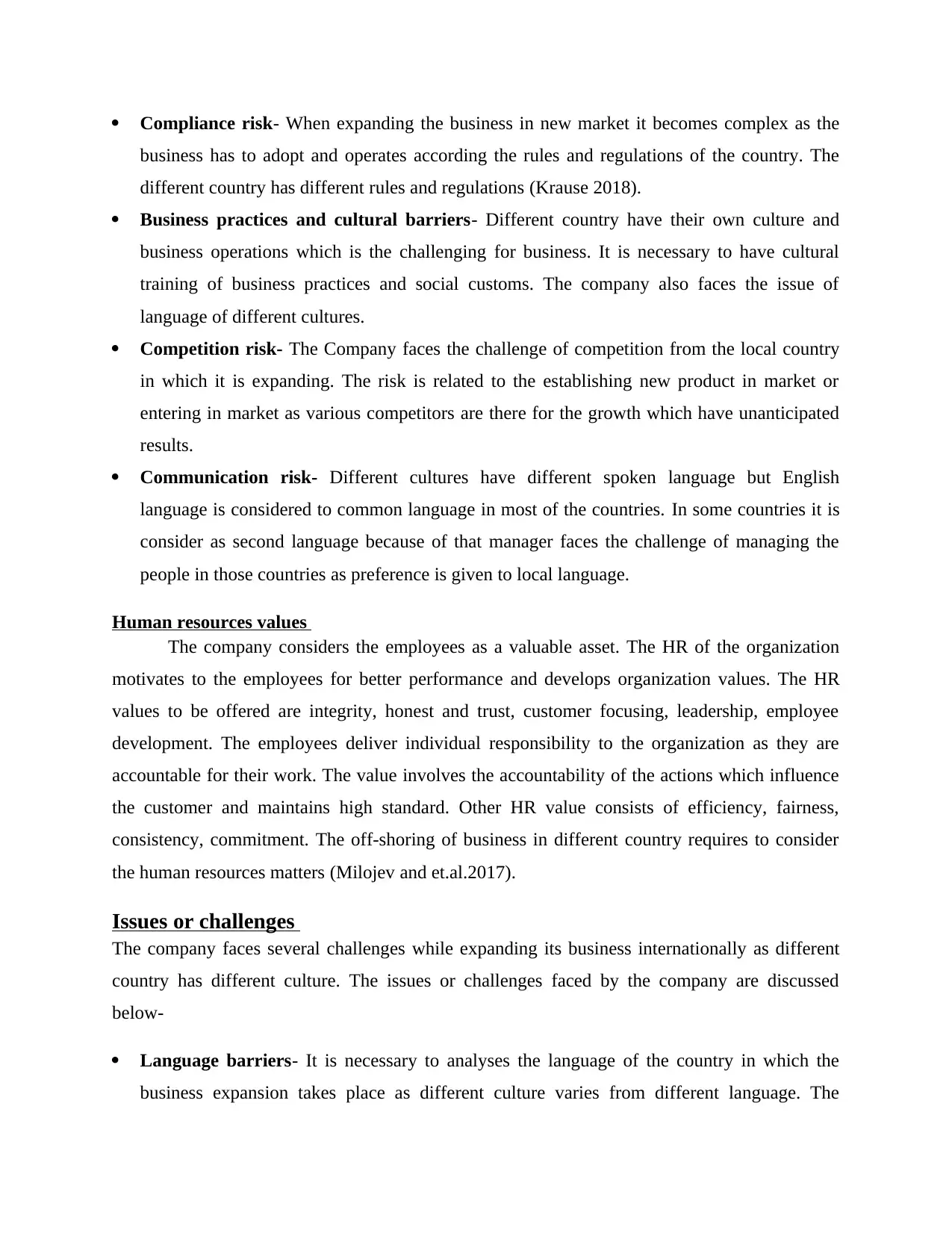
Compliance risk- When expanding the business in new market it becomes complex as the
business has to adopt and operates according the rules and regulations of the country. The
different country has different rules and regulations (Krause 2018).
Business practices and cultural barriers- Different country have their own culture and
business operations which is the challenging for business. It is necessary to have cultural
training of business practices and social customs. The company also faces the issue of
language of different cultures.
Competition risk- The Company faces the challenge of competition from the local country
in which it is expanding. The risk is related to the establishing new product in market or
entering in market as various competitors are there for the growth which have unanticipated
results.
Communication risk- Different cultures have different spoken language but English
language is considered to common language in most of the countries. In some countries it is
consider as second language because of that manager faces the challenge of managing the
people in those countries as preference is given to local language.
Human resources values
The company considers the employees as a valuable asset. The HR of the organization
motivates to the employees for better performance and develops organization values. The HR
values to be offered are integrity, honest and trust, customer focusing, leadership, employee
development. The employees deliver individual responsibility to the organization as they are
accountable for their work. The value involves the accountability of the actions which influence
the customer and maintains high standard. Other HR value consists of efficiency, fairness,
consistency, commitment. The off-shoring of business in different country requires to consider
the human resources matters (Milojev and et.al.2017).
Issues or challenges
The company faces several challenges while expanding its business internationally as different
country has different culture. The issues or challenges faced by the company are discussed
below-
Language barriers- It is necessary to analyses the language of the country in which the
business expansion takes place as different culture varies from different language. The
business has to adopt and operates according the rules and regulations of the country. The
different country has different rules and regulations (Krause 2018).
Business practices and cultural barriers- Different country have their own culture and
business operations which is the challenging for business. It is necessary to have cultural
training of business practices and social customs. The company also faces the issue of
language of different cultures.
Competition risk- The Company faces the challenge of competition from the local country
in which it is expanding. The risk is related to the establishing new product in market or
entering in market as various competitors are there for the growth which have unanticipated
results.
Communication risk- Different cultures have different spoken language but English
language is considered to common language in most of the countries. In some countries it is
consider as second language because of that manager faces the challenge of managing the
people in those countries as preference is given to local language.
Human resources values
The company considers the employees as a valuable asset. The HR of the organization
motivates to the employees for better performance and develops organization values. The HR
values to be offered are integrity, honest and trust, customer focusing, leadership, employee
development. The employees deliver individual responsibility to the organization as they are
accountable for their work. The value involves the accountability of the actions which influence
the customer and maintains high standard. Other HR value consists of efficiency, fairness,
consistency, commitment. The off-shoring of business in different country requires to consider
the human resources matters (Milojev and et.al.2017).
Issues or challenges
The company faces several challenges while expanding its business internationally as different
country has different culture. The issues or challenges faced by the company are discussed
below-
Language barriers- It is necessary to analyses the language of the country in which the
business expansion takes place as different culture varies from different language. The
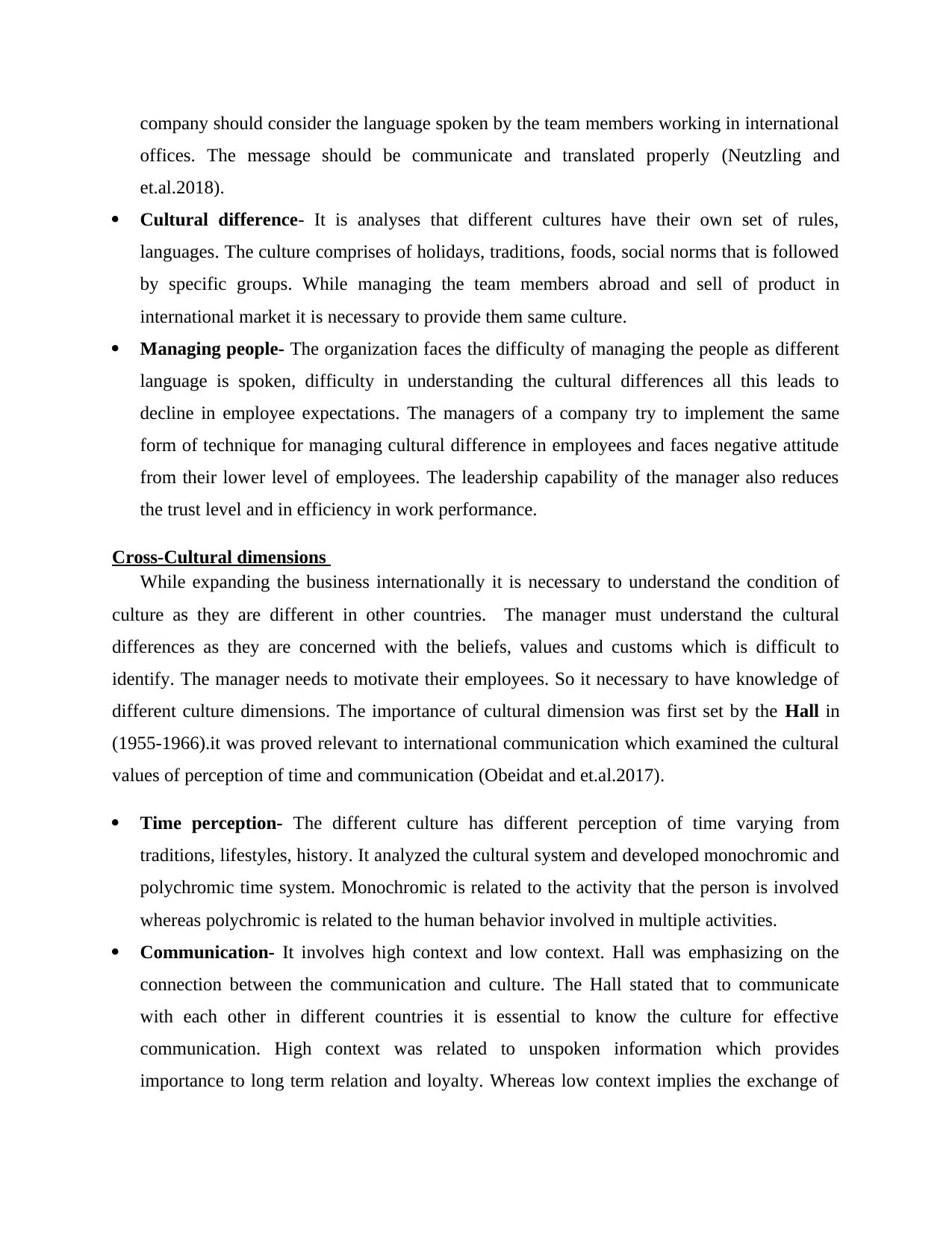
company should consider the language spoken by the team members working in international
offices. The message should be communicate and translated properly (Neutzling and
et.al.2018).
Cultural difference- It is analyses that different cultures have their own set of rules,
languages. The culture comprises of holidays, traditions, foods, social norms that is followed
by specific groups. While managing the team members abroad and sell of product in
international market it is necessary to provide them same culture.
Managing people- The organization faces the difficulty of managing the people as different
language is spoken, difficulty in understanding the cultural differences all this leads to
decline in employee expectations. The managers of a company try to implement the same
form of technique for managing cultural difference in employees and faces negative attitude
from their lower level of employees. The leadership capability of the manager also reduces
the trust level and in efficiency in work performance.
Cross-Cultural dimensions
While expanding the business internationally it is necessary to understand the condition of
culture as they are different in other countries. The manager must understand the cultural
differences as they are concerned with the beliefs, values and customs which is difficult to
identify. The manager needs to motivate their employees. So it necessary to have knowledge of
different culture dimensions. The importance of cultural dimension was first set by the Hall in
(1955-1966).it was proved relevant to international communication which examined the cultural
values of perception of time and communication (Obeidat and et.al.2017).
Time perception- The different culture has different perception of time varying from
traditions, lifestyles, history. It analyzed the cultural system and developed monochromic and
polychromic time system. Monochromic is related to the activity that the person is involved
whereas polychromic is related to the human behavior involved in multiple activities.
Communication- It involves high context and low context. Hall was emphasizing on the
connection between the communication and culture. The Hall stated that to communicate
with each other in different countries it is essential to know the culture for effective
communication. High context was related to unspoken information which provides
importance to long term relation and loyalty. Whereas low context implies the exchange of
offices. The message should be communicate and translated properly (Neutzling and
et.al.2018).
Cultural difference- It is analyses that different cultures have their own set of rules,
languages. The culture comprises of holidays, traditions, foods, social norms that is followed
by specific groups. While managing the team members abroad and sell of product in
international market it is necessary to provide them same culture.
Managing people- The organization faces the difficulty of managing the people as different
language is spoken, difficulty in understanding the cultural differences all this leads to
decline in employee expectations. The managers of a company try to implement the same
form of technique for managing cultural difference in employees and faces negative attitude
from their lower level of employees. The leadership capability of the manager also reduces
the trust level and in efficiency in work performance.
Cross-Cultural dimensions
While expanding the business internationally it is necessary to understand the condition of
culture as they are different in other countries. The manager must understand the cultural
differences as they are concerned with the beliefs, values and customs which is difficult to
identify. The manager needs to motivate their employees. So it necessary to have knowledge of
different culture dimensions. The importance of cultural dimension was first set by the Hall in
(1955-1966).it was proved relevant to international communication which examined the cultural
values of perception of time and communication (Obeidat and et.al.2017).
Time perception- The different culture has different perception of time varying from
traditions, lifestyles, history. It analyzed the cultural system and developed monochromic and
polychromic time system. Monochromic is related to the activity that the person is involved
whereas polychromic is related to the human behavior involved in multiple activities.
Communication- It involves high context and low context. Hall was emphasizing on the
connection between the communication and culture. The Hall stated that to communicate
with each other in different countries it is essential to know the culture for effective
communication. High context was related to unspoken information which provides
importance to long term relation and loyalty. Whereas low context implies the exchange of
⊘ This is a preview!⊘
Do you want full access?
Subscribe today to unlock all pages.

Trusted by 1+ million students worldwide
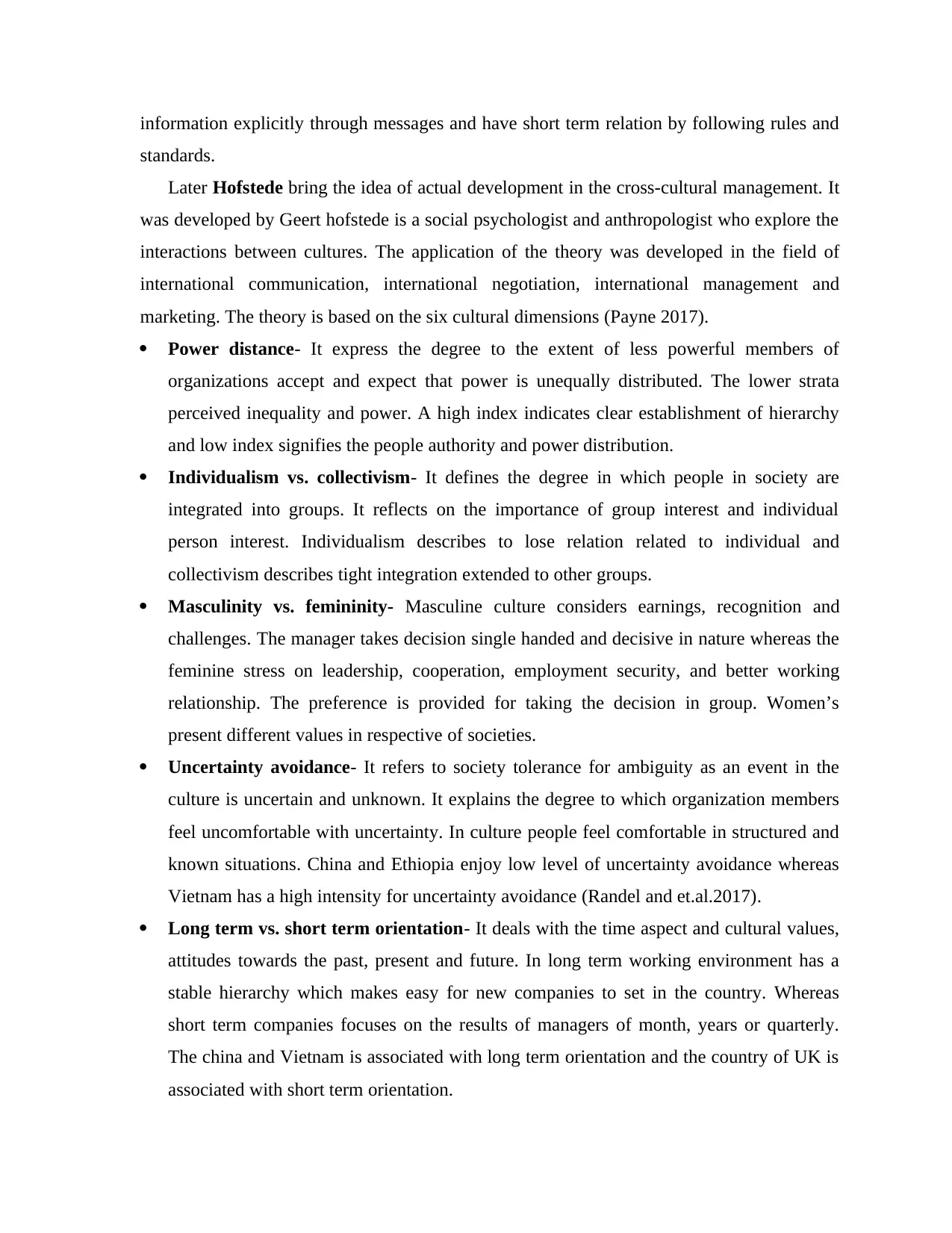
information explicitly through messages and have short term relation by following rules and
standards.
Later Hofstede bring the idea of actual development in the cross-cultural management. It
was developed by Geert hofstede is a social psychologist and anthropologist who explore the
interactions between cultures. The application of the theory was developed in the field of
international communication, international negotiation, international management and
marketing. The theory is based on the six cultural dimensions (Payne 2017).
Power distance- It express the degree to the extent of less powerful members of
organizations accept and expect that power is unequally distributed. The lower strata
perceived inequality and power. A high index indicates clear establishment of hierarchy
and low index signifies the people authority and power distribution.
Individualism vs. collectivism- It defines the degree in which people in society are
integrated into groups. It reflects on the importance of group interest and individual
person interest. Individualism describes to lose relation related to individual and
collectivism describes tight integration extended to other groups.
Masculinity vs. femininity- Masculine culture considers earnings, recognition and
challenges. The manager takes decision single handed and decisive in nature whereas the
feminine stress on leadership, cooperation, employment security, and better working
relationship. The preference is provided for taking the decision in group. Women’s
present different values in respective of societies.
Uncertainty avoidance- It refers to society tolerance for ambiguity as an event in the
culture is uncertain and unknown. It explains the degree to which organization members
feel uncomfortable with uncertainty. In culture people feel comfortable in structured and
known situations. China and Ethiopia enjoy low level of uncertainty avoidance whereas
Vietnam has a high intensity for uncertainty avoidance (Randel and et.al.2017).
Long term vs. short term orientation- It deals with the time aspect and cultural values,
attitudes towards the past, present and future. In long term working environment has a
stable hierarchy which makes easy for new companies to set in the country. Whereas
short term companies focuses on the results of managers of month, years or quarterly.
The china and Vietnam is associated with long term orientation and the country of UK is
associated with short term orientation.
standards.
Later Hofstede bring the idea of actual development in the cross-cultural management. It
was developed by Geert hofstede is a social psychologist and anthropologist who explore the
interactions between cultures. The application of the theory was developed in the field of
international communication, international negotiation, international management and
marketing. The theory is based on the six cultural dimensions (Payne 2017).
Power distance- It express the degree to the extent of less powerful members of
organizations accept and expect that power is unequally distributed. The lower strata
perceived inequality and power. A high index indicates clear establishment of hierarchy
and low index signifies the people authority and power distribution.
Individualism vs. collectivism- It defines the degree in which people in society are
integrated into groups. It reflects on the importance of group interest and individual
person interest. Individualism describes to lose relation related to individual and
collectivism describes tight integration extended to other groups.
Masculinity vs. femininity- Masculine culture considers earnings, recognition and
challenges. The manager takes decision single handed and decisive in nature whereas the
feminine stress on leadership, cooperation, employment security, and better working
relationship. The preference is provided for taking the decision in group. Women’s
present different values in respective of societies.
Uncertainty avoidance- It refers to society tolerance for ambiguity as an event in the
culture is uncertain and unknown. It explains the degree to which organization members
feel uncomfortable with uncertainty. In culture people feel comfortable in structured and
known situations. China and Ethiopia enjoy low level of uncertainty avoidance whereas
Vietnam has a high intensity for uncertainty avoidance (Randel and et.al.2017).
Long term vs. short term orientation- It deals with the time aspect and cultural values,
attitudes towards the past, present and future. In long term working environment has a
stable hierarchy which makes easy for new companies to set in the country. Whereas
short term companies focuses on the results of managers of month, years or quarterly.
The china and Vietnam is associated with long term orientation and the country of UK is
associated with short term orientation.
Paraphrase This Document
Need a fresh take? Get an instant paraphrase of this document with our AI Paraphraser
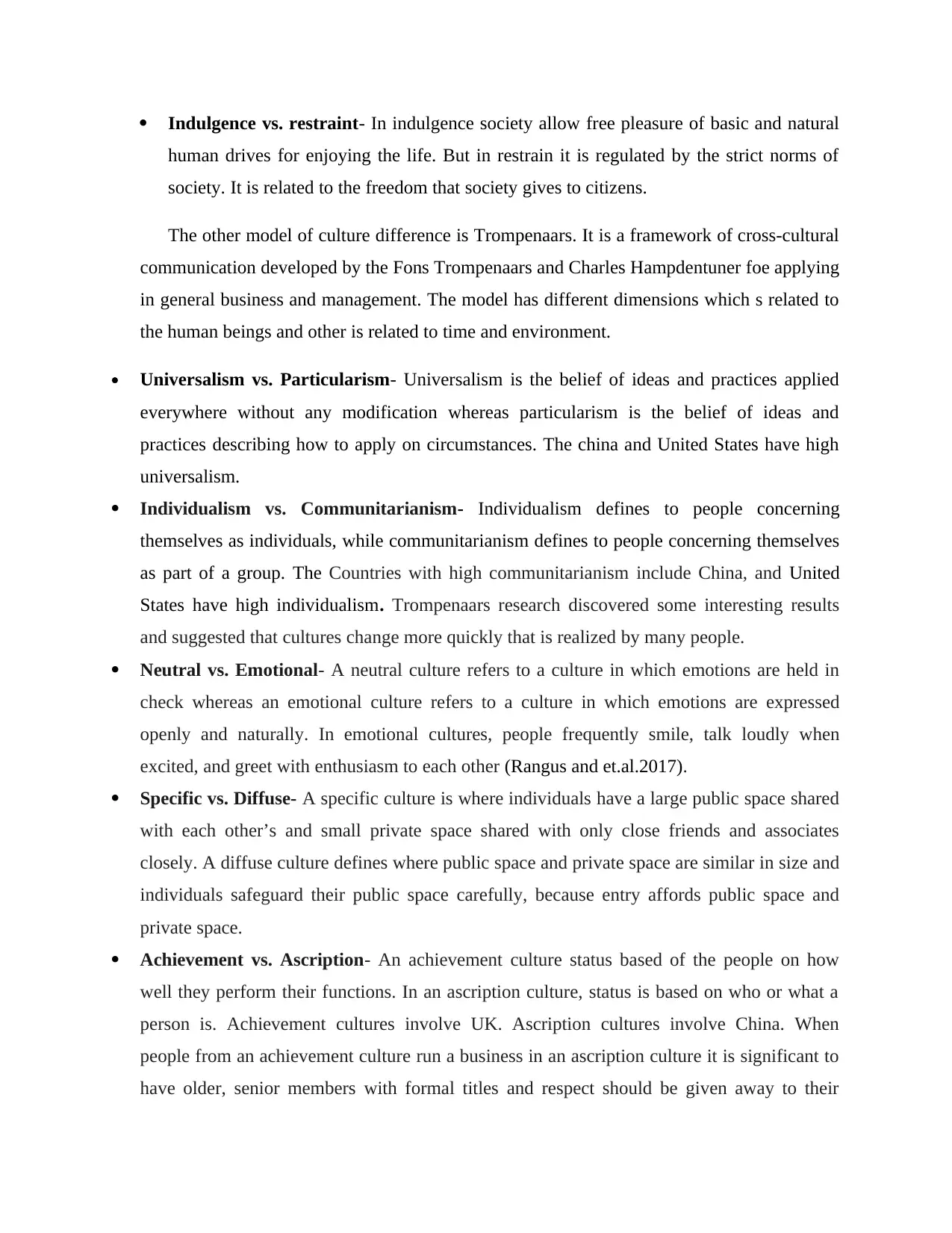
Indulgence vs. restraint- In indulgence society allow free pleasure of basic and natural
human drives for enjoying the life. But in restrain it is regulated by the strict norms of
society. It is related to the freedom that society gives to citizens.
The other model of culture difference is Trompenaars. It is a framework of cross-cultural
communication developed by the Fons Trompenaars and Charles Hampdentuner foe applying
in general business and management. The model has different dimensions which s related to
the human beings and other is related to time and environment.
Universalism vs. Particularism- Universalism is the belief of ideas and practices applied
everywhere without any modification whereas particularism is the belief of ideas and
practices describing how to apply on circumstances. The china and United States have high
universalism.
Individualism vs. Communitarianism- Individualism defines to people concerning
themselves as individuals, while communitarianism defines to people concerning themselves
as part of a group. The Countries with high communitarianism include China, and United
States have high individualism. Trompenaars research discovered some interesting results
and suggested that cultures change more quickly that is realized by many people.
Neutral vs. Emotional- A neutral culture refers to a culture in which emotions are held in
check whereas an emotional culture refers to a culture in which emotions are expressed
openly and naturally. In emotional cultures, people frequently smile, talk loudly when
excited, and greet with enthusiasm to each other (Rangus and et.al.2017).
Specific vs. Diffuse- A specific culture is where individuals have a large public space shared
with each other’s and small private space shared with only close friends and associates
closely. A diffuse culture defines where public space and private space are similar in size and
individuals safeguard their public space carefully, because entry affords public space and
private space.
Achievement vs. Ascription- An achievement culture status based of the people on how
well they perform their functions. In an ascription culture, status is based on who or what a
person is. Achievement cultures involve UK. Ascription cultures involve China. When
people from an achievement culture run a business in an ascription culture it is significant to
have older, senior members with formal titles and respect should be given away to their
human drives for enjoying the life. But in restrain it is regulated by the strict norms of
society. It is related to the freedom that society gives to citizens.
The other model of culture difference is Trompenaars. It is a framework of cross-cultural
communication developed by the Fons Trompenaars and Charles Hampdentuner foe applying
in general business and management. The model has different dimensions which s related to
the human beings and other is related to time and environment.
Universalism vs. Particularism- Universalism is the belief of ideas and practices applied
everywhere without any modification whereas particularism is the belief of ideas and
practices describing how to apply on circumstances. The china and United States have high
universalism.
Individualism vs. Communitarianism- Individualism defines to people concerning
themselves as individuals, while communitarianism defines to people concerning themselves
as part of a group. The Countries with high communitarianism include China, and United
States have high individualism. Trompenaars research discovered some interesting results
and suggested that cultures change more quickly that is realized by many people.
Neutral vs. Emotional- A neutral culture refers to a culture in which emotions are held in
check whereas an emotional culture refers to a culture in which emotions are expressed
openly and naturally. In emotional cultures, people frequently smile, talk loudly when
excited, and greet with enthusiasm to each other (Rangus and et.al.2017).
Specific vs. Diffuse- A specific culture is where individuals have a large public space shared
with each other’s and small private space shared with only close friends and associates
closely. A diffuse culture defines where public space and private space are similar in size and
individuals safeguard their public space carefully, because entry affords public space and
private space.
Achievement vs. Ascription- An achievement culture status based of the people on how
well they perform their functions. In an ascription culture, status is based on who or what a
person is. Achievement cultures involve UK. Ascription cultures involve China. When
people from an achievement culture run a business in an ascription culture it is significant to
have older, senior members with formal titles and respect should be given away to their
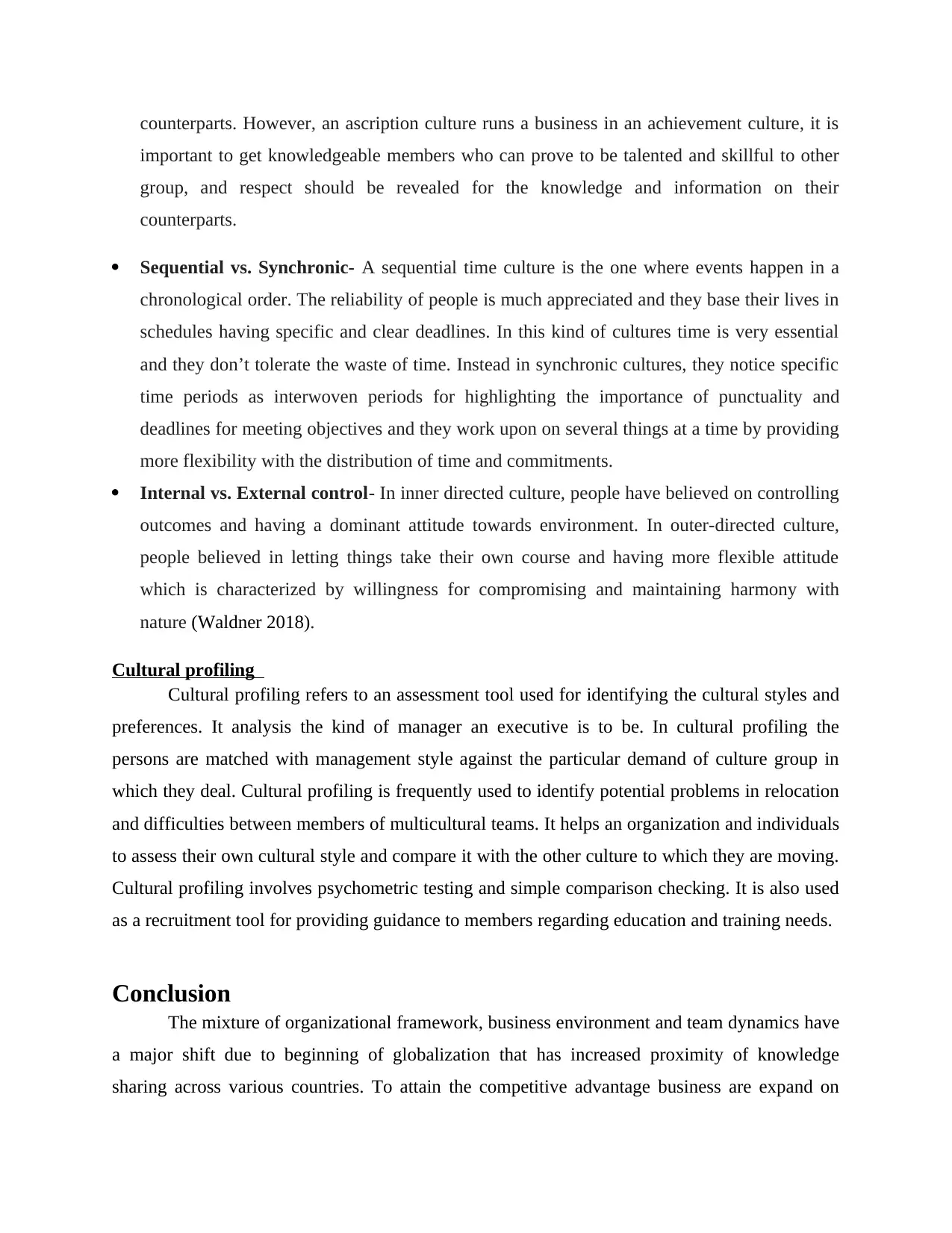
counterparts. However, an ascription culture runs a business in an achievement culture, it is
important to get knowledgeable members who can prove to be talented and skillful to other
group, and respect should be revealed for the knowledge and information on their
counterparts.
Sequential vs. Synchronic- A sequential time culture is the one where events happen in a
chronological order. The reliability of people is much appreciated and they base their lives in
schedules having specific and clear deadlines. In this kind of cultures time is very essential
and they don’t tolerate the waste of time. Instead in synchronic cultures, they notice specific
time periods as interwoven periods for highlighting the importance of punctuality and
deadlines for meeting objectives and they work upon on several things at a time by providing
more flexibility with the distribution of time and commitments.
Internal vs. External control- In inner directed culture, people have believed on controlling
outcomes and having a dominant attitude towards environment. In outer-directed culture,
people believed in letting things take their own course and having more flexible attitude
which is characterized by willingness for compromising and maintaining harmony with
nature (Waldner 2018).
Cultural profiling
Cultural profiling refers to an assessment tool used for identifying the cultural styles and
preferences. It analysis the kind of manager an executive is to be. In cultural profiling the
persons are matched with management style against the particular demand of culture group in
which they deal. Cultural profiling is frequently used to identify potential problems in relocation
and difficulties between members of multicultural teams. It helps an organization and individuals
to assess their own cultural style and compare it with the other culture to which they are moving.
Cultural profiling involves psychometric testing and simple comparison checking. It is also used
as a recruitment tool for providing guidance to members regarding education and training needs.
Conclusion
The mixture of organizational framework, business environment and team dynamics have
a major shift due to beginning of globalization that has increased proximity of knowledge
sharing across various countries. To attain the competitive advantage business are expand on
important to get knowledgeable members who can prove to be talented and skillful to other
group, and respect should be revealed for the knowledge and information on their
counterparts.
Sequential vs. Synchronic- A sequential time culture is the one where events happen in a
chronological order. The reliability of people is much appreciated and they base their lives in
schedules having specific and clear deadlines. In this kind of cultures time is very essential
and they don’t tolerate the waste of time. Instead in synchronic cultures, they notice specific
time periods as interwoven periods for highlighting the importance of punctuality and
deadlines for meeting objectives and they work upon on several things at a time by providing
more flexibility with the distribution of time and commitments.
Internal vs. External control- In inner directed culture, people have believed on controlling
outcomes and having a dominant attitude towards environment. In outer-directed culture,
people believed in letting things take their own course and having more flexible attitude
which is characterized by willingness for compromising and maintaining harmony with
nature (Waldner 2018).
Cultural profiling
Cultural profiling refers to an assessment tool used for identifying the cultural styles and
preferences. It analysis the kind of manager an executive is to be. In cultural profiling the
persons are matched with management style against the particular demand of culture group in
which they deal. Cultural profiling is frequently used to identify potential problems in relocation
and difficulties between members of multicultural teams. It helps an organization and individuals
to assess their own cultural style and compare it with the other culture to which they are moving.
Cultural profiling involves psychometric testing and simple comparison checking. It is also used
as a recruitment tool for providing guidance to members regarding education and training needs.
Conclusion
The mixture of organizational framework, business environment and team dynamics have
a major shift due to beginning of globalization that has increased proximity of knowledge
sharing across various countries. To attain the competitive advantage business are expand on
⊘ This is a preview!⊘
Do you want full access?
Subscribe today to unlock all pages.

Trusted by 1+ million students worldwide
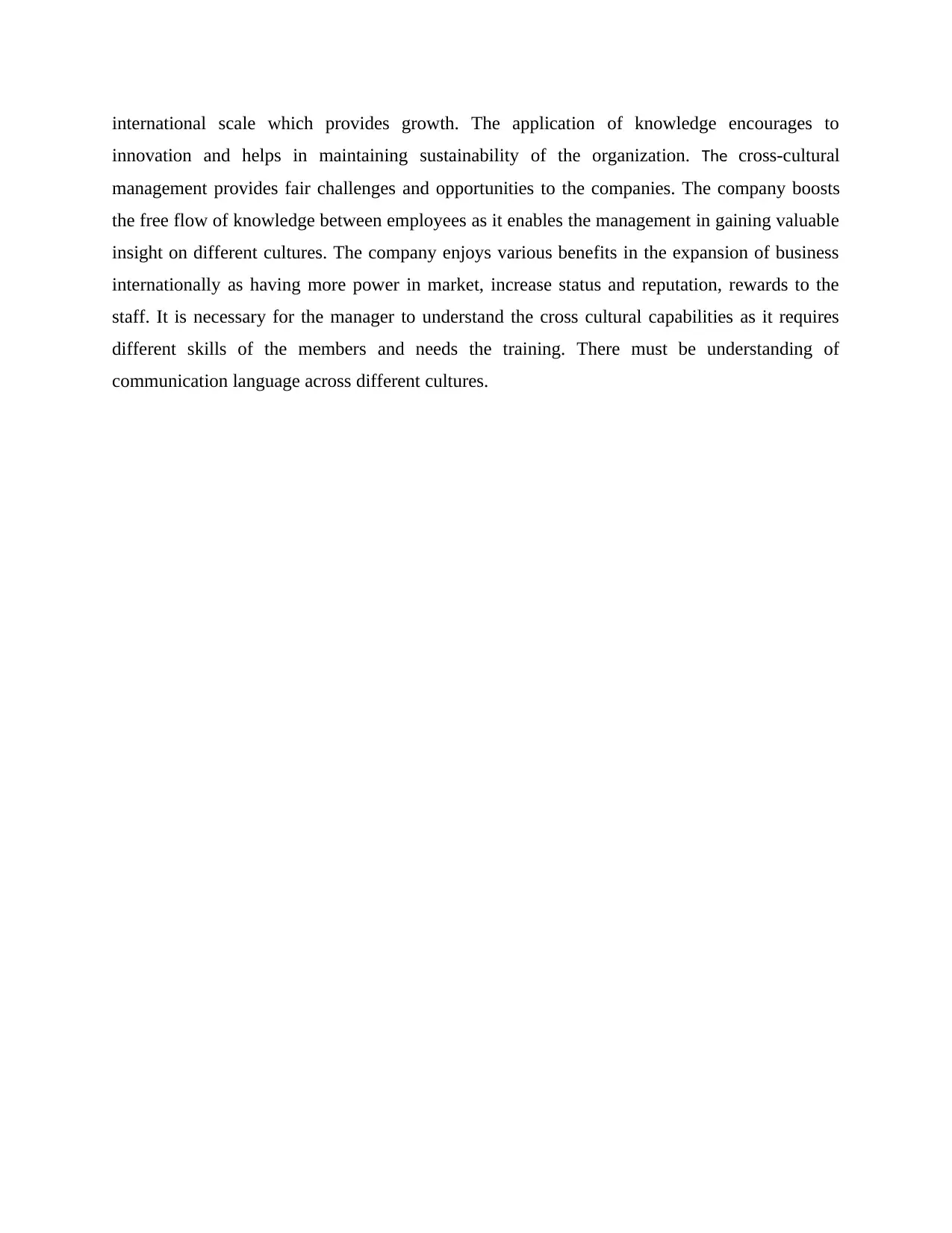
international scale which provides growth. The application of knowledge encourages to
innovation and helps in maintaining sustainability of the organization. The cross-cultural
management provides fair challenges and opportunities to the companies. The company boosts
the free flow of knowledge between employees as it enables the management in gaining valuable
insight on different cultures. The company enjoys various benefits in the expansion of business
internationally as having more power in market, increase status and reputation, rewards to the
staff. It is necessary for the manager to understand the cross cultural capabilities as it requires
different skills of the members and needs the training. There must be understanding of
communication language across different cultures.
innovation and helps in maintaining sustainability of the organization. The cross-cultural
management provides fair challenges and opportunities to the companies. The company boosts
the free flow of knowledge between employees as it enables the management in gaining valuable
insight on different cultures. The company enjoys various benefits in the expansion of business
internationally as having more power in market, increase status and reputation, rewards to the
staff. It is necessary for the manager to understand the cross cultural capabilities as it requires
different skills of the members and needs the training. There must be understanding of
communication language across different cultures.
Paraphrase This Document
Need a fresh take? Get an instant paraphrase of this document with our AI Paraphraser
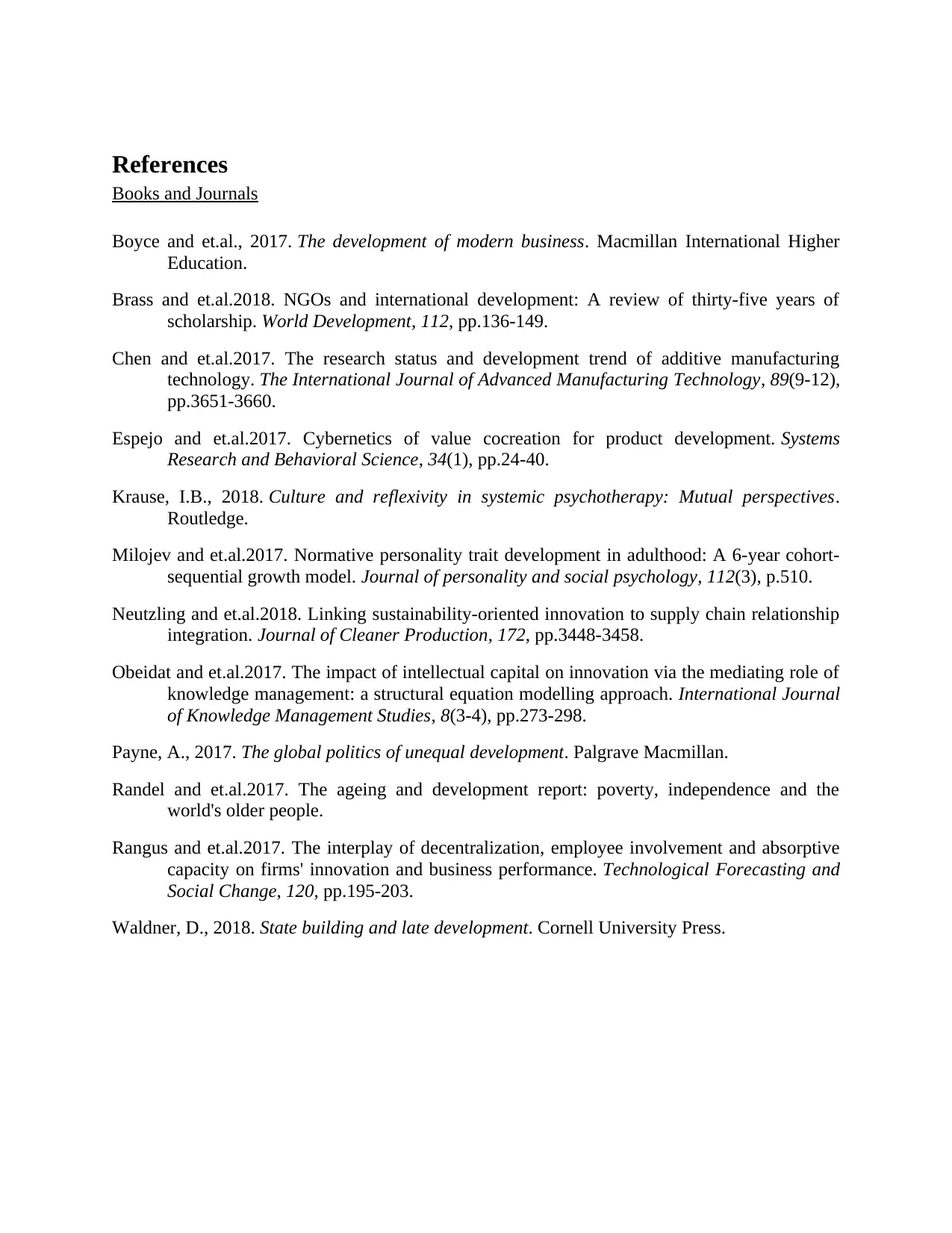
References
Books and Journals
Boyce and et.al., 2017. The development of modern business. Macmillan International Higher
Education.
Brass and et.al.2018. NGOs and international development: A review of thirty-five years of
scholarship. World Development, 112, pp.136-149.
Chen and et.al.2017. The research status and development trend of additive manufacturing
technology. The International Journal of Advanced Manufacturing Technology, 89(9-12),
pp.3651-3660.
Espejo and et.al.2017. Cybernetics of value cocreation for product development. Systems
Research and Behavioral Science, 34(1), pp.24-40.
Krause, I.B., 2018. Culture and reflexivity in systemic psychotherapy: Mutual perspectives.
Routledge.
Milojev and et.al.2017. Normative personality trait development in adulthood: A 6-year cohort-
sequential growth model. Journal of personality and social psychology, 112(3), p.510.
Neutzling and et.al.2018. Linking sustainability-oriented innovation to supply chain relationship
integration. Journal of Cleaner Production, 172, pp.3448-3458.
Obeidat and et.al.2017. The impact of intellectual capital on innovation via the mediating role of
knowledge management: a structural equation modelling approach. International Journal
of Knowledge Management Studies, 8(3-4), pp.273-298.
Payne, A., 2017. The global politics of unequal development. Palgrave Macmillan.
Randel and et.al.2017. The ageing and development report: poverty, independence and the
world's older people.
Rangus and et.al.2017. The interplay of decentralization, employee involvement and absorptive
capacity on firms' innovation and business performance. Technological Forecasting and
Social Change, 120, pp.195-203.
Waldner, D., 2018. State building and late development. Cornell University Press.
Books and Journals
Boyce and et.al., 2017. The development of modern business. Macmillan International Higher
Education.
Brass and et.al.2018. NGOs and international development: A review of thirty-five years of
scholarship. World Development, 112, pp.136-149.
Chen and et.al.2017. The research status and development trend of additive manufacturing
technology. The International Journal of Advanced Manufacturing Technology, 89(9-12),
pp.3651-3660.
Espejo and et.al.2017. Cybernetics of value cocreation for product development. Systems
Research and Behavioral Science, 34(1), pp.24-40.
Krause, I.B., 2018. Culture and reflexivity in systemic psychotherapy: Mutual perspectives.
Routledge.
Milojev and et.al.2017. Normative personality trait development in adulthood: A 6-year cohort-
sequential growth model. Journal of personality and social psychology, 112(3), p.510.
Neutzling and et.al.2018. Linking sustainability-oriented innovation to supply chain relationship
integration. Journal of Cleaner Production, 172, pp.3448-3458.
Obeidat and et.al.2017. The impact of intellectual capital on innovation via the mediating role of
knowledge management: a structural equation modelling approach. International Journal
of Knowledge Management Studies, 8(3-4), pp.273-298.
Payne, A., 2017. The global politics of unequal development. Palgrave Macmillan.
Randel and et.al.2017. The ageing and development report: poverty, independence and the
world's older people.
Rangus and et.al.2017. The interplay of decentralization, employee involvement and absorptive
capacity on firms' innovation and business performance. Technological Forecasting and
Social Change, 120, pp.195-203.
Waldner, D., 2018. State building and late development. Cornell University Press.
1 out of 11
Related Documents
Your All-in-One AI-Powered Toolkit for Academic Success.
+13062052269
info@desklib.com
Available 24*7 on WhatsApp / Email
![[object Object]](/_next/static/media/star-bottom.7253800d.svg)
Unlock your academic potential
Copyright © 2020–2025 A2Z Services. All Rights Reserved. Developed and managed by ZUCOL.





